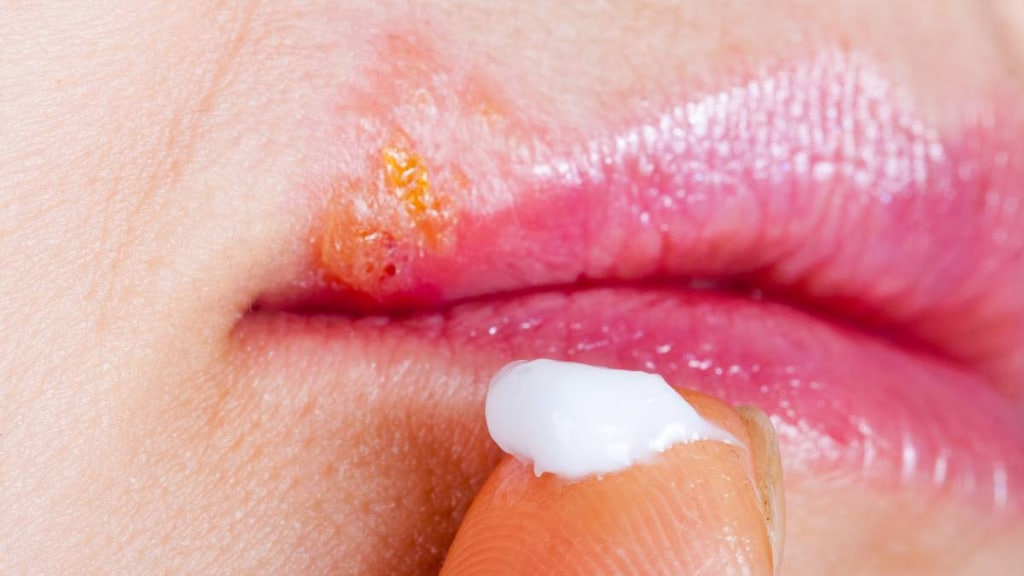Dosage Forms
Excipient information presented when available (limited, particularly for generics); consult specific product labeling.
Cream, External:
Denavir: 1% (5 g) [contains cetostearyl alcohol, propylene glycol]
Pharmacology
Mechanism of Action
In cells infected with HSV-1 or HSV-2, viral thymidine kinase phosphorylates penciclovir to a monophosphate form which, in turn, is converted to penciclovir triphosphate by cellular kinases. Penciclovir triphosphate inhibits HSV polymerase competitively with deoxyguanosine triphosphate. Consequently, herpes viral DNA synthesis and, therefore, replication are selectively inhibited
Pharmacokinetics/Pharmacodynamics
Absorption
Topical: None
Onset of Action
Resolution of pain: Adults: 3.5 days (Spruance 1997); Cutaneous healing: Adults: 4.8 days (Spruance 1997)
Use: Labeled Indications
Herpes labialis (cold sores): Topical treatment of recurrent herpes labialis (cold sores) adults and children ≥12 years of age
Contraindications
Hypersensitivity to the penciclovir or any component of the formulation
Dosage and Administration
Dosing: Adult
Herpes labialis (cold sores): Topical: Apply cream at the first sign or symptom of cold sore (eg, tingling, swelling) or appearance of lesion; apply every 2 hours during waking hours for 4 days.
Dosing: Geriatric
Refer to adult dosing.
Dosing: Pediatric
Herpes labialis (cold sores): Children ≥12 years and Adolescents: Topical: Cream: Apply every 2 hours during waking hours for 4 days; start at the first sign or symptom of cold sore (eg, tingling, redness, itching, swelling) or appearance of lesion
Administration
Topical: Apply only to herpes labialis on the lips and face. Clean and dry affected area prior to application. Apply sufficient amount to cover lesions or area of tingling (or other symptoms) before the lesion appears; gently rub into the affected area. Avoid application in or near eyes since it may cause irritation. Wash hands with soap and water after application.
Storage
Store at controlled room temperature of 20°C to 25°C (68°F to 77°F).
Drug Interactions
Talimogene Laherparepvec: Antiherpetic Antivirals may diminish the therapeutic effect of Talimogene Laherparepvec. Monitor therapy
Adverse Reactions
>10%: Dermatologic: Erythema (50%; mild)
1% to 10%:
Central nervous system: Headache (5%)
Local: Application site reaction (1%)
<1%, postmarketing, and/or case reports: Altered sense of smell, erythematous rash, local anesthesia, localized edema, oropharyngeal edema, pain, paresthesia, pruritus, skin discoloration, urticaria
Warnings/Precautions
Special populations:
- Immunocompromised patients: The effect of penciclovir has not been established in immunocompromised patients.
Other warnings/precautions:
- Appropriate use: Should only be used on herpes labialis on the lips and face; because no data are available, application to mucous membranes is not recommended. Avoid application in or near eyes since it may cause irritation.
Monitoring Parameters
Resolution of symptoms and healing of cold sore lesion
Pregnancy
Pregnancy Considerations
Penciclovir is not absorbed systemically following topical administration; exposure to the fetus is not expected.
Patient Education
- Discuss specific use of drug and side effects with patient as it relates to treatment. (HCAHPS: During this hospital stay, were you given any medicine that you had not taken before? Before giving you any new medicine, how often did hospital staff tell you what the medicine was for? How often did hospital staff describe possible side effects in a way you could understand?)
- Patient may experience change in taste. Have patient report immediately to prescriber severe skin irritation (HCAHPS).
- Educate patient about signs of a significant reaction (eg, wheezing; chest tightness; fever; itching; bad cough; blue skin color; seizures; or swelling of face, lips, tongue, or throat). Note: This is not a comprehensive list of all side effects. Patient should consult prescriber for additional questions.
Intended Use and Disclaimer: Should not be printed and given to patients. This information is intended to serve as a concise initial reference for health care professionals to use when discussing medications with a patient. You must ultimately rely on your own discretion, experience, and judgment in diagnosing, treating, and advising patients.
